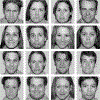Free viewing of sad and happy faces in depression: A potential target for attention bias modification
- PMID: 29870821
- PMCID: PMC6310000
- DOI: 10.1016/j.jad.2018.05.047
Free viewing of sad and happy faces in depression: A potential target for attention bias modification
Abstract
Background: Identification of reliable targets for therapeutic interventions is essential for developing evidence-based therapies. Attention biases toward negative-valenced information and lack of protective positive bias toward positive-valenced stimuli have been implicated in depression. However, extant research has typically used tasks with narrow stimuli arrays and unknown or poor psychometric properties. Here, we recorded eye-tracking data of depressed and non-depressed participants during a free viewing task to address these limitations.
Methods: Patients with major depressive disorder (MDD; n = 20) and undergraduate students with high (n = 23) and low (n = 20) levels of depression freely viewed 60 different face-based matrices for six seconds each. Each matrix included eight sad and eight happy facial expressions. Gaze patterns on sad and happy areas of interest (AOIs) were explored. Internal consistency for the entire sample and one-week test-retest reliability in the student sub-sample were assessed.
Results: Compared to undergraduates with low levels of depression, patients with MDD and students with high levels of depression dwelled significantly longer on sad faces. Results also showed a significantly longer dwell time on the happy AOI relative to the sad AOI only in the low depression group. The two depressed groups dwelled equally on the two AOIs. The task demonstrated high internal consistency and acceptable one-week test-retest reliability.
Limitations: Only sad and happy facial expressions were used. Relative small sample size.
Conclusion: Relative to non-depressed participants, depressed participants showed prolonged dwelling on sad faces and lack of bias toward happy faces. These biases present viable targets for gaze-contingent attention bias modification therapy.
Keywords: Attention allocation; Attention bias; Attention bias modification; Depression; Eye tracking; Reliability.
Copyright © 2018. Published by Elsevier B.V.
Figures


Similar articles
-
Aberrant attentional bias to sad faces in depression and the role of stressful life events: Evidence from an eye-tracking paradigm.Behav Res Ther. 2020 Dec;135:103762. doi: 10.1016/j.brat.2020.103762. Epub 2020 Nov 1. Behav Res Ther. 2020. PMID: 33160270
-
Biased attention allocation in major depressive disorder: A replication and exploration of the potential effects of depression history.J Affect Disord. 2025 Apr 1;374:258-266. doi: 10.1016/j.jad.2025.01.058. Epub 2025 Jan 12. J Affect Disord. 2025. PMID: 39809354
-
Social anxiety is related to increased dwell time on socially threatening faces.J Affect Disord. 2016 Mar 15;193:282-8. doi: 10.1016/j.jad.2016.01.007. Epub 2016 Jan 12. J Affect Disord. 2016. PMID: 26774515 Clinical Trial.
-
Attentional processes during emotional face perception in social anxiety disorder: A systematic review and meta-analysis of eye-tracking findings.Prog Neuropsychopharmacol Biol Psychiatry. 2021 Dec 20;111:110353. doi: 10.1016/j.pnpbp.2021.110353. Epub 2021 May 15. Prog Neuropsychopharmacol Biol Psychiatry. 2021. PMID: 34000291
-
Attentional biases to emotional information in clinical depression: A systematic and meta-analytic review of eye tracking findings.J Affect Disord. 2020 Sep 1;274:632-642. doi: 10.1016/j.jad.2020.05.140. Epub 2020 May 29. J Affect Disord. 2020. PMID: 32663997 Review.
Cited by
-
An influence of menopausal symptoms on mental health, emotion perception, and quality of life: a multi-faceted approach.Qual Life Res. 2024 Jul;33(7):1925-1935. doi: 10.1007/s11136-024-03641-z. Epub 2024 May 3. Qual Life Res. 2024. PMID: 38700754
-
Depression, family interaction and family intervention in adolescents at clinical-high risk for psychosis.Early Interv Psychiatry. 2021 Apr;15(2):360-366. doi: 10.1111/eip.12954. Epub 2020 Mar 30. Early Interv Psychiatry. 2021. PMID: 32232954 Free PMC article. Clinical Trial.
-
A randomized controlled trial of gaze-contingent music reward therapy for major depressive disorder.Depress Anxiety. 2021 Feb;38(2):134-145. doi: 10.1002/da.23089. Epub 2020 Aug 12. Depress Anxiety. 2021. PMID: 32790036 Free PMC article. Clinical Trial.
-
AI-assisted multi-modal information for the screening of depression: a systematic review and meta-analysis.NPJ Digit Med. 2025 Aug 16;8(1):523. doi: 10.1038/s41746-025-01933-3. NPJ Digit Med. 2025. PMID: 40819119 Free PMC article.
-
Depression and Cognitive Impairment: Current Understanding of Its Neurobiology and Diagnosis.Neuropsychiatr Dis Treat. 2022 Nov 29;18:2783-2794. doi: 10.2147/NDT.S383093. eCollection 2022. Neuropsychiatr Dis Treat. 2022. PMID: 36471744 Free PMC article. Review.
References
-
- Alloy LB, Abramson LY, 1979. Judgment of contingency in depressed and non-depressed students: Sadder but wiser. J. Exp. Psychol 108 (4), 441–485. - PubMed
-
- Alloy LB, Abramson LY, 1988. Chapter: depressive realism: four theoretical perspectives (Ed.) In: Alloy LB (Ed.), Cognitive Processes in Depression Guilford Press; US, New York, NY, pp. 223–265.
-
- American Psychiatric Association, 1994. Diagnostic and Statistical Manual of Mental Disorders, fourth ed. American Psychiatric Publishing, Washington, DC.
-
- Beck AT, 1967. Depression: Causes and Treatment University of Pennsylvania Press, Philadelphia, PA.
Publication types
MeSH terms
Grants and funding
LinkOut - more resources
Full Text Sources
Other Literature Sources
Medical

